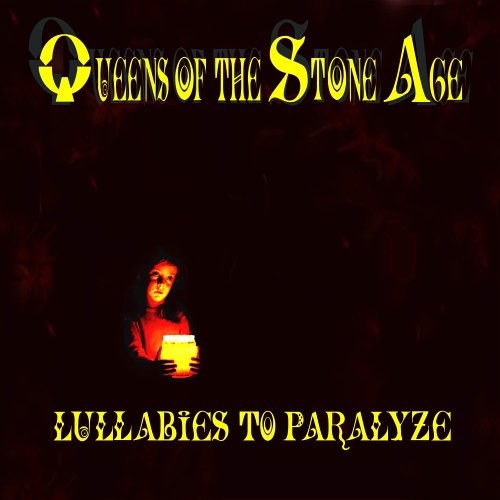Queens of the Stone Age returns after a six-year hiatus with their newest, weirdest, reddest release, ...Like Clockwork (typing out those "..." is going to get old really fast) showing a modern day spin on the Phantom of the Opera with some chick crying blue. Ya know, like we all do when we're held tight by a man wearing a skull mask. Lead singer Josh Homme employed his BFF Dave Grohl along with other contributors Trent Reznor, Mark Lanegan, and Queen of the Modern Age, Elton John, leaving fans to hope that they threw the most glitterly, twisted, dark get-togethers to watch the new Liberace biopic Behind the Candelabra while reading 1984. With a pretty extensive and cryptic publicity push through its release, the album leaves fans wondering, "what does it all mean??" But like wondering how to pronounce Josh Homme's last name (hom-mee? ho-mee? Gr-ohl?), sometimes it's better not to ask questions...or really wonder at all.
Queens of the Stone Age (or "Queens" or "QOTSA" or "Eagles of Death Metal" or "Them Crooked Vultures" or "anything else Josh Homme has ever done") is known for being a band that not only makes you take the time to think about their music, but also question the legitimate meaning behind their album covers. Let's take a look at their most well known release, 2002's Songs for the Deaf (what? WHAT?), a concept album about taking you on a road trip from Los Angeles to the Joshua Tree through the Bible Belt of California.
That then brings us to 2007's Era Vulgaris featuring two lovable lightbulbs, Bulby and his pal Stumpy the Pirate (how many Josh Homme's does it take to name a lightbulb?). This fluorescent duo shines brighter than any cartoon pairing I knew of growing up. Brighter than Batman and Robin, flashier than Tommy and Chuckie, shinier than Barnacle Boy and Mermaid Man – their action figures could have been luminously lovely: "Bash out some tunes with Bulby! Complete with working cigarette and razor-sharp edged head! Don't forget about his washed up pal Stumpy the Pirate, complete with hat, eyepatch, peg-leg, and refund for purchasing this album for thinking it would be good after playing '3's & 7's' in Guitar Hero!" In a perfect world, I like to think these two are best buds with the phallic-like Mandy and Brandy from Tool's Vicarious video and have crazy playdates and play "Trip Acid Like We're In A 90's German Domination Club" instead of "House" or "Doctor."
And now ...Like Clockwork has arrived. The band gained notoriety earlier in the year when they released cryptic hand-written letters to various music magazines talking about how they've been dealing with dark times, emotions, having no control, something about codeine cabarets, etc.
This lead to the release of a handful of music videos which turned out to be cartoons of mostly human beings wearing what looks to be BDSM clothing set in a Quentin Tarantino fantasy-blood-world. Combine that with a creative execution that allows fans to enter in their phone numbers and receive a weird voice message from Josh Homme and you've got a pretty cool tactic to make some buzz. But what do these themes of time, and cryptic messages, and darkness have to do with the album's cover? Nothing. Could the skeleton-mask man represent dark emotions and the woman (supposedly Homme's wife) represent how the band had no control over their direction and they let their emotions take over? Just like what we saw with Songs for the Deaf's "religious tones," this isn't a commentary on anything. It's just some guy on Photoshop who had a cool idea.







No comments:
Post a Comment